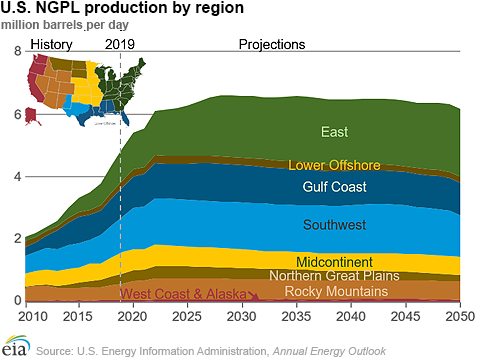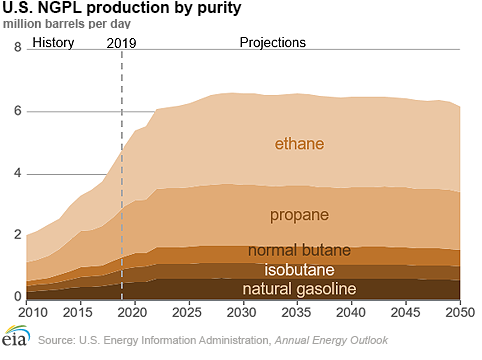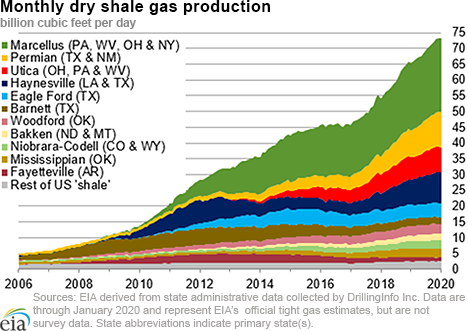In the News:
EIA’s Annual Energy Outlook projects continuing growth for natural gas plant liquids
U.S. production of natural gas plant liquids (NGPL), which includes the recovery of ethane, propane, normal butane, isobutane, and natural gasoline from raw natural gas processed at gas processing plants, has been growing rapidly and exceeded 4.8 million barrels per day (b/d) in 2019. EIA’s Annual Energy Outlook (AEO2020) projects this rapid pace of growth will persist through 2022, when production is projected to exceed 6.0 million b/d. The AEO2020 Reference case, which was released at the end of January, projects U.S. production of NGPL to reach a peak of 6.6 million b/d in 2029 and average close to 6.5 million b/d through the mid-2040s before slowly tapering off to 6.2 million b/d by the end of 2050.
Strong growth in natural gas production is the primary contributor to rapid NGPL production growth. Natural gas demand gas been rising rapidly in the United States, and domestic consumption and exports have set new records. Because most raw natural gas does not meet quality requirements for end-use markets, more than 60% of the natural gas produced must be processed at natural gas processing plants. These plants remove impurities such as water and inert gasses and separate out NGPLs, yielding a dry gas stream suitable for interstate pipeline transport. The NGPLs then undergo fractionation, a secondary refining process, which separates the products into their individual purity streams.
The pace of NGPL production growth is also tied to the quality of natural gas produced. Raw natural gas produced in areas such as the Permian Basin in western Texas or the Marcellus formation in the Northeast yields higher quantities of liquids than natural gas produced from conventional natural gas fields in the Midwest. Producers tend to target resources richer in liquids, which generate higher revenues than dry gas alone. As a result, EIA projects a growing share of U.S. NGPL production to come from two producing regions: the East Region, which includes the Marcellus and Utica formations, and the Southwest Region, which includes the Permian Basin. Together, these regions are projected to contribute more than 50% of U.S. NGPL production through 2050, the end of the projection period. Production in the Midcontinent, on the other hand, is projected to remain fairly flat and decline as a share of total U.S. NGPL production.
EIA also projects a gradual change in the composition of the NGPL mix produced. As demand for ethane, a petrochemical feedstock, continues to rise, ethane recovery at natural gas processing plants is also expected to continue to rise. Except in 2019, ethane has been the fastest-growing NGPL, and EIA expects this pace to continue through the mid-2020s, when ethane’s share of total NGPLs is expected to increase from the current 39% to nearly 45%.
Overview:
(For the week ending Wednesday, March 11, 2020)
- Natural gas spot prices rose at most locations this report week (Wednesday, March 4 to Wednesday, March 11). The Henry Hub spot price rose from $1.80 per million British thermal units (MMBtu) last Wednesday to $1.92/MMBtu yesterday.
- At the New York Mercantile Exchange (Nymex), the price of the April 2020 contract increased 5¢, from $1.827/MMBtu last Wednesday to $1.878/MMBtu yesterday. The price of the 12-month strip averaging April 2020 through March 2021 futures contracts climbed 8¢/MMBtu to $2.238/MMBtu.
- The net withdrawal from working gas totaled 48 billion cubic feet (Bcf) for the week ending March 6. Working natural gas stocks total 2,043 Bcf, which is 64% more than the year-ago level and 13% more than the five-year (2015–19) average for this week.
- The natural gas plant liquids composite price at Mont Belvieu, Texas, fell by 62¢/MMBtu, averaging $3.69/MMBtu for the week ending March 11. Because crude oil prices generally set the ceiling for natural gas plant liquids (NGPL) while natural gas prices set the floor, and crude oil prices fell rapidly while natural gas prices held steady, heavier NGPL saw larger price declines (natural gasoline, butane, and isobutane fell by 20%, 22%, and 29%, respectively) than lighter NGPL (ethane fell by 5% and propane fell by 9%).
- According to Baker Hughes, for the week ending Tuesday, March 3, the natural gas rig count decreased by 1 to 109. The number of oil-directed rigs rose by 4 to 682. The total rig count increased by 3, and it now stands at 793.
Prices/Supply/Demand:
Prices rise across the Lower 48 states amid energy market volatility. This report week (Wednesday, March 4, to Wednesday, March 11), the Henry Hub spot price rose 12¢ from $1.80/MMBtu last Wednesday to a high of $1.92/MMBtu yesterday.
Natural gas prices have been a relatively stable commodity in the global energy sector, which experienced high volatility this week following the outcome of the meeting between the Organization of the Petroleum Exporting Countries (OPEC) and its partners on March 6, and amid concerns over the economic effects of the 2019 novel coronavirus disease (COVID-19). U.S. natural gas prices in particular largely reflect domestic supply and demand dynamics compared with oil prices, which are largely driven by global trends.
Temperatures were generally warmer than normal across most of the country, especially in the Northeast and Midwest regions. At the Chicago Citygate, the price increased 13¢ from $1.66/MMBtu last Wednesday to a high of $1.79/MMBtu yesterday.
California prices rise. The price at PG&E Citygate in Northern California rose 16¢, up from $2.68/MMBtu last Wednesday to a high of $2.84/MMBtu yesterday.
The price at SoCal Citygate in Southern California increased 38¢ from $2.02/MMBtu last Wednesday to a high of $2.40/MMBtu yesterday. On Tuesday, El Paso Natural Gas Pipeline Company declared a force majeure at the Topock compressor station in San Bernadino, California, located at the California-Arizona border. The outage has reduced capacity through the pipeline at this location by about 50–100 million cubic feet per day (MMcf/d) until further notice, according to Natural Gas Intelligence.
Northeast prices rise. At the Algonquin Citygate, which serves Boston-area consumers, the price went up 6¢ from $1.69/MMBtu last Wednesday to $1.75/MMBtu yesterday. At the Transcontinental Pipeline Zone 6 trading point for New York City, the price increased 3¢ from $1.66/MMBtu last Wednesday to $1.69/MMBtu yesterday.
The Tennessee Zone 4 Marcellus spot price increased 7¢ from $1.45/MMBtu last Wednesday to $1.52/MMBtu yesterday. The price at Dominion South in southwest Pennsylvania rose 1¢ from $1.51/MMBtu last Wednesday to $1.52/MMBtu yesterday.
Permian Basin prices strengthen throughout the week as producers prepare to scale back activity. The price at the Waha Hub in West Texas, which is located near Permian Basin production activities, averaged a low of $0.29/MMBtu last Wednesday, $1.51/MMBtu lower than the Henry Hub price. Yesterday, the price at the Waha Hub averaged a high of $0.96/MMBtu, 96¢/MMBtu lower than the Henry Hub price.
Permian Basin prices ended the week at a high amid uncertainty about future oil and natural gas production. On March 9, the Brent crude oil front-month futures price fell to less than $35/b, a 24% daily decline and the second-largest daily price decline on record. Prices fell following the March 6 meeting between members of the Organization of the Petroleum Exporting Countries (OPEC) and its partner countries, which ended without an agreement on production levels amid market expectations for declining global oil demand growth in the coming months. See more data and analysis in EIA’s Short-Term Energy Outlook, released yesterday.
Supply falls. According to data from IHS Markit, the average total supply of natural gas fell by 1% compared with the previous report week. Dry natural gas production remained unchanged week over week. Average net imports from Canada decreased by 20% from last week with warmer-than-normal temperatures in U.S. Northeast and Midwestern markets.
Demand falls with warm temperatures. Total U.S. consumption of natural gas fell by 10% compared with the previous report week, according to data from IHS Markit. Declines were largest in the residential and commercial sectors, where consumption declined by 20% with lower demand for space heating. Natural gas consumed for power generation declined by 6% week over week. Industrial sector consumption decreased by 2% week over week. Natural gas exports to Mexico were unchanged from last week, averaging 5.5 Bcf/d.
U.S. liquefied natural gas (LNG) exports decrease week over week. Fourteen LNG vessels (seven from Sabine Pass, two each from Cameron, Corpus Christi, and Freeport, and one from Cove Point) with a combined LNG-carrying capacity of 51 Bcf departed the United States between March 5 and March 11, 2020, according to shipping data compiled by Bloomberg. One vessel was loading at the Cameron terminal on Wednesday.
Freeport LNG export terminal located on Quintana Island, Texas, received a letter order from the Federal Energy Regulatory Commission (FERC) authorizing the facility to “commission and introduce hazardous fluids to Train 3 and associated utility systems.” FERC also issued a letter order authorizing Freeport LNG to place Dock 2 at the liquefaction facility in service.
Storage:
The net withdrawal from storage totaled 48 Bcf for the week ending March 6, compared with the five-year (2015–19) average net withdrawal of 99 Bcf and last year's net withdrawal of 164 Bcf during the same week. Working natural gas stocks totaled 2,043 Bcf, which is 227 Bcf more than the five-year average and 796 Bcf more than last year at this time.
According to The Desk survey of natural gas analysts, estimates of the weekly net change to working natural gas stocks ranged from a net withdrawal of 45 Bcf to 66 Bcf, with a median estimate of 56 Bcf.
The average rate of withdrawal from storage is 10% lower than the five-year average so far in the withdrawal season (November through March). If the rate of withdrawal from storage matched the five-year average of 4.7 Bcf/d for the remainder of the withdrawal season, the total inventory would be 1,924 Bcf on March 31, which is 227 Bcf higher than the five-year average of 1,697 Bcf for that time of year.
More storage data and analysis can be found on the Natural Gas Storage Dashboard and the Weekly Natural Gas Storage Report.
See also:
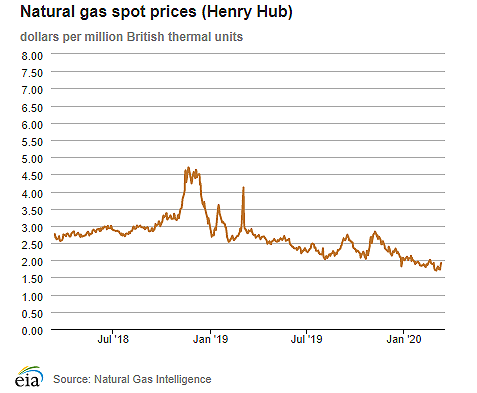
| Spot Prices ($/MMBtu) | Thu, 05-Mar |
Fri, 06-Mar |
Mon, 09-Mar |
Tue, 10-Mar |
Wed, 11-Mar |
|---|---|---|---|---|---|
| Henry Hub |
1.82 |
1.75 |
1.73 |
1.85 |
1.92 |
| New York |
1.68 |
1.54 |
1.43 |
1.58 |
1.69 |
| Chicago |
1.65 |
1.53 |
1.55 |
1.67 |
1.79 |
| Cal. Comp. Avg.* |
1.93 |
1.86 |
1.91 |
2.02 |
2.24 |
| Futures ($/MMBtu) | |||||
| April contract | 1.772 |
1.708 |
1.778 |
1.936 |
1.878 |
| May contract |
1.813 |
1.748 |
1.819 |
1.985 |
1.921 |
| *Avg. of NGI's reported prices for: Malin, PG&E Citygate, and Southern California Border Avg. | |||||
| Source: NGI's Daily Gas Price Index | |||||
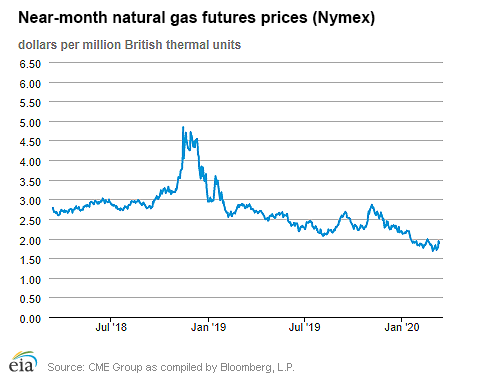
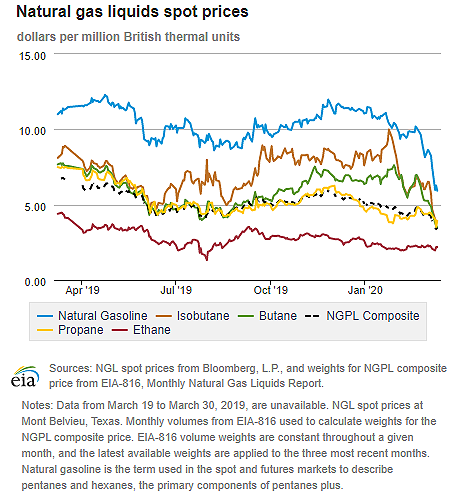
| U.S. natural gas supply - Gas Week: (3/5/20 - 3/11/20) | |||
|---|---|---|---|
Average daily values (Bcf/d): |
|||
this week |
last week |
last year |
|
| Marketed production | 106.0 |
106.4 |
99.8 |
| Dry production | 94.2 |
94.6 |
88.5 |
| Net Canada imports | 3.7 |
4.6 |
5.2 |
| LNG pipeline deliveries | 0.2 |
0.2 |
0.2 |
| Total supply | 98.1 |
99.4 |
93.9 |
|
Source: IHS Markit | |||
| U.S. natural gas consumption - Gas Week: (3/5/20 - 3/11/20) | |||
|---|---|---|---|
Average daily values (Bcf/d): |
|||
this week |
last week |
last year |
|
| U.S. consumption | 81.4 |
90.8 |
94.1 |
| Power | 28.1 |
29.8 |
27.3 |
| Industrial | 25.8 |
26.3 |
23.9 |
| Residential/commercial | 27.5 |
34.6 |
42.8 |
| Mexico exports | 5.5 |
5.5 |
4.9 |
| Pipeline fuel use/losses | 6.9 |
7.2 |
7.0 |
| LNG pipeline receipts | 8.0 |
8.1 |
4.9 |
| Total demand | 101.9 |
111.6 |
110.9 |
|
Source: IHS Markit | |||
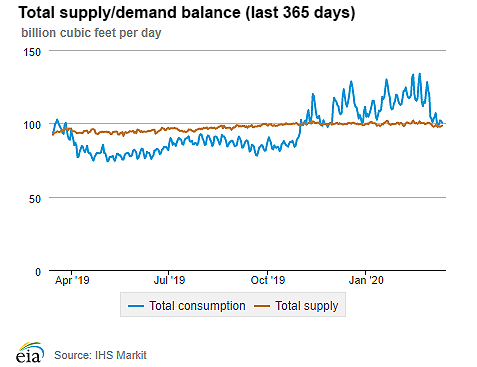
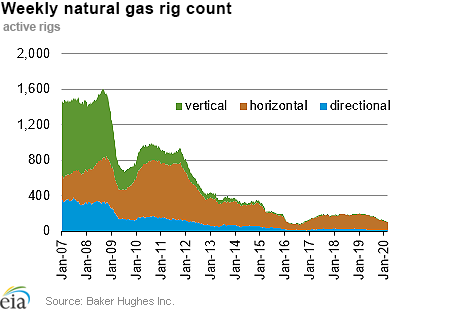
| Rigs | |||
|---|---|---|---|
Tue, March 03, 2020 |
Change from |
||
last week |
last year |
||
| Oil rigs | 682 |
0.6% |
-18.2% |
| Natural gas rigs | 109 |
-0.9% |
-43.5% |
| Note: Excludes any miscellaneous rigs | |||
| Rig numbers by type | |||
|---|---|---|---|
Tue, March 03, 2020 |
Change from |
||
last week |
last year |
||
| Vertical | 34 |
-5.6% |
-39.3% |
| Horizontal | 708 |
0.0% |
-21.7% |
| Directional | 51 |
10.9% |
-23.9% |
| Source: Baker Hughes Inc. | |||
| Working gas in underground storage | ||||
|---|---|---|---|---|
Stocks billion cubic feet (Bcf) |
||||
| Region | 2020-03-06 |
2020-02-28 |
change |
|
| East | 426 |
451 |
-25 |
|
| Midwest | 529 |
558 |
-29 |
|
| Mountain | 97 |
101 |
-4 |
|
| Pacific | 200 |
197 |
3 |
|
| South Central | 791 |
784 |
7 |
|
| Total | 2,043 |
2,091 |
-48 |
|
|
Source: Form EIA-912, Weekly Underground Natural Gas Storage Report | ||||
| Working gas in underground storage | |||||
|---|---|---|---|---|---|
Historical comparisons |
|||||
Year ago (3/6/19) |
5-year average (2015-2019) |
||||
| Region | Stocks (Bcf) |
% change |
Stocks (Bcf) |
% change |
|
| East | 276 |
54.3 |
353 |
20.7 |
|
| Midwest | 302 |
75.2 |
424 |
24.8 |
|
| Mountain | 68 |
42.6 |
112 |
-13.4 |
|
| Pacific | 105 |
90.5 |
199 |
0.5 |
|
| South Central | 497 |
59.2 |
727 |
8.8 |
|
| Total | 1,247 |
63.8 |
1,816 |
12.5 |
|
| Source: Form EIA-912, Weekly Underground Natural Gas Storage Report | |||||
| Temperature – heating & cooling degree days (week ending Mar 05) | ||||||||
|---|---|---|---|---|---|---|---|---|
HDD deviation from: |
CDD deviation from: |
|||||||
| Region | HDD Current |
normal |
last year |
CDD Current |
normal |
last year |
||
| New England | 198 |
-32 |
-75 |
0 |
0 |
0 |
||
| Middle Atlantic | 187 |
-30 |
-78 |
0 |
0 |
0 |
||
| E N Central | 209 |
-22 |
-110 |
0 |
-1 |
0 |
||
| W N Central | 191 |
-40 |
-181 |
0 |
0 |
0 |
||
| South Atlantic | 128 |
-6 |
-22 |
10 |
0 |
-2 |
||
| E S Central | 108 |
-21 |
-68 |
0 |
-3 |
0 |
||
| W S Central | 55 |
-27 |
-103 |
11 |
2 |
10 |
||
| Mountain | 163 |
-14 |
-38 |
0 |
-1 |
-1 |
||
| Pacific | 81 |
-15 |
-27 |
0 |
-1 |
0 |
||
| United States | 150 |
-22 |
-79 |
3 |
0 |
1 |
||
|
Note: HDD = heating degree day; CDD = cooling degree day Source: National Oceanic and Atmospheric Administration | ||||||||
Average temperature (°F)
7-day mean ending Mar 05, 2020
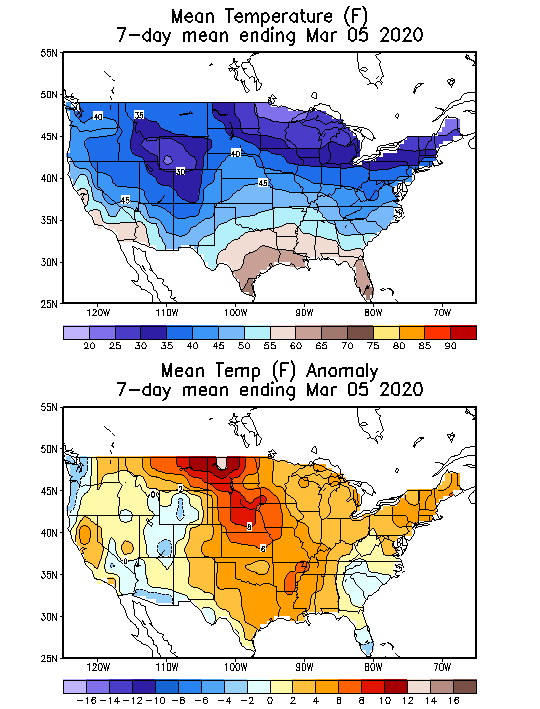
Source: National Oceanic and Atmospheric Administration
Deviation between average and normal (°F)
7-day mean ending Mar 05, 2020

Source: National Oceanic and Atmospheric Administration

